Experimental Study on the Flexural Creep Behaviors of Pultruded Unidirectional Carbon/Glass Fiber-Reinforced Hybrid Bars
Abstract
1. Introduction
2. Materials and Methods
2.1. HFRP Bars
2.2. Freeze Thaw Conditining
2.3. Time-Independent Static Flexural Test
2.4. Time-Dependent Creep Test at Room Temperature
2.5. Time-Dependent Creep Test under Combined Freeze–thaw Cycle Conditioning and Loading
2.6. Scanning Electron Microscopy
3. Results and Discussion
3.1. Short-Term Flexural Properties
3.2. Long-Term Creep Testing
3.3. Evaluation of Creep and Viscoelastic Modelling Utilizing Findley’s Power Law
3.4. Prediction of Viscoelastic Properties
3.5. Prediction of Time-Dependent Modulus
3.6. Design Formulation and Verification for Viscoelastic Modulus
3.7. Prediction of Long-Term Flexural Mid-Span Deflection
3.8. Microstructural Analysis
4. Conclusions
Author Contributions
Funding
Conflicts of Interest
References
- Xin, H.; Liu, Y.; Mosallam, A.; Zhang, Y.; Wang, C. Hygrothermal aging effects on flexural behavior of pultruded glass fiber reinforced polymer laminates in bridge applications. Constr. Build. Mater. 2016, 127, 237–247. [Google Scholar] [CrossRef]
- Li, C.; Xian, G.; Li, H. Influence of immersion in water under hydraulic pressure on the interfacial shear strength of a unidirectional carbon/glass hybrid rod. Polym. Test. 2018, 72, 164–171. [Google Scholar] [CrossRef]
- Grammatikos, S.A.; Evernden, M.; Mitchels, J.; Zafarid, B.; Mottramd, J.T.; Papanicolaou, G.C. Onthe response to hygrothermal aging of pultruded FRPs used in the civil engineering sector. Mater. Des. 2016, 96, 283–295. [Google Scholar] [CrossRef]
- Najafabadi, E.P.; Bazli, M.; Ashrafi, H.; Oskouei, A.V. Effect of applied stress and bar characteristics on the short-term creep behavior of FRP bars. Constr. Build. Mater. 2018, 171, 960–968. [Google Scholar] [CrossRef]
- Wang, Z.; Zhao, X.-L.; Xian, G.; Wu, G.; Raman, R.K.S.; Al-Saadi, S. Effect of sustained load and seawater and sea sand concrete environment on durability of basalt- and glass-fibre reinforced polymer (B/GFRP) bars. Corros. Sci. 2018, 138, 200–218. [Google Scholar] [CrossRef]
- Peng, F.; Xue, W.; Tan, Y. Design approach for flexural capacity of prestressed concrete beams with external tendons. J. Struct. Eng. 2018, 144, 04018215. [Google Scholar] [CrossRef]
- Wang, X.; Shi, J.; Wu, G.; Yang, L.; Wu, Z. Effectiveness of basalt FRP tendons for strengthening of RC beams through the external prestressing technique. Eng. Struct. 2015, 101, 34–44. [Google Scholar] [CrossRef]
- Wang, X.; Wang, Z.; Wu, Z.; Chenga, F. Shear behavior of basalt fiber reinforced polymer (FRP) and hybrid FRP rods as shear resistance members. Constr. Build. Mater. 2014, 73, 781–789. [Google Scholar] [CrossRef]
- Wang, X.; Shi, J.; Liu, J.; Yang, L.; Wu, Z. Creep behavior of basalt fiber reinforced polymer tendons for prestressing application. Mater. Des. 2014, 59, 558–564. [Google Scholar] [CrossRef]
- Li, C.; Xian, G.; Li, H. Tension-tension fatigue performance of a large-diameter pultruded carbon/glass hybrid rod. Int. J. Fatigue 2018, 84. [Google Scholar] [CrossRef]
- Zhu, H.; Dong, Z.-Q.; Wu, G.; Chen, H.-Y.; Li, J.; Liu, Y. Experimental evaluation of bent FRP tendons for strengthening by external prestressing. J. Compos. Constr. 2017, 21, 04017032. [Google Scholar] [CrossRef]
- Le, T.D.; Phama, T.M.; Hao, H.; Hao, Y. Flexural behaviour of precast segmental concrete beams internally prestressed with unbonded CFRP tendons under four-point loading. Eng. Struct. 2018, 168, 371–383. [Google Scholar] [CrossRef]
- Sas-Jaworsky, A.; Williams, J.G. Composite Rod-Stffened Spoolable Cable with Conductors. U.S. Patent 5,234,058, 10 August 1993. [Google Scholar]
- Weatherford (Ed.) Continuous Rod for Medium- to Heavy-Load Reciprocating Rod Lift (rrl) and Progressing Cavity Pumping (pcp) in Wells that are Noncorrosive or Mildly Corrosive but Effectively Inhibited; Weatherford: Houston, TX, USA, 2016. [Google Scholar]
- Ali, R.M.H.; Muliana, A.H. A micromechanical constitutive framework for the nonlinear viscoelastic behavior of pultruded composite materials. Int. J. Solids Struct. 2003, 40, 1037–1057. [Google Scholar]
- Yang, Z.; Wang, H.; Ma, X.; Shang, F.; Ma, Y.; Shao, Z.; Hou, D. Flexural creep tests and long-term mechanical behavior of fiber-reinforced polymeric composite tubes. Compos. Struct. 2018, 193, 154–164. [Google Scholar] [CrossRef]
- Etches, J.; Potter, K.; Weaver, P.; Bond, I. Environmental effects on thermally induced multistability in unsymmetric composite laminates. Compos. A Appl. Sci. Manuf. 2009, 40, 1240–1247. [Google Scholar] [CrossRef]
- Ray, B.C. Effects of changing environment and loading speed on mechanical behavior of frp composites. J. Reinf. Plast. Compos. 2006, 25, 1227–1240. [Google Scholar] [CrossRef]
- Grammatikos, S.A.; Jones, R.G.; Evernden, M.; Correia, J.R. Thermal cycling effects on the durability of a pultruded GFRP material for off-shore civil engineering structures. Compos. Struct. 2016, 153, 297–310. [Google Scholar] [CrossRef]
- Filippo, M.D.; Alessi, S.; Pitarresi, G.; Sabatino, M.A.; Zucchelli, A.; Dispenza, C. Hydrothermal aging of carbon reinforced epoxy laminates with nanofibrous mats as toughening interlayers. Polym. Degrad. Stab. 2016, 126, 188–195. [Google Scholar] [CrossRef]
- Lubineau, G.; Ladevèze, P.; Violeau, D. Durability of CFRP laminates under thermomechanical loading: A micro-meso damage model. Compos. Sci. Technol. 2006, 66, 983–992. [Google Scholar] [CrossRef]
- Li, C.; Xian, G.; Li, H. Water absorption and distribution in a pultruded unidirectional carbon/glass hybrid rod under hydraulic pressure and elevated temperatures. Polymers 2018, 10, 627. [Google Scholar] [CrossRef]
- Nkurunziza, G.; Debaiky, A.; Cousin, P.; Benmokrane, B. Durability of GFRP bars: A critical review of the literature. Prog. Struct. Eng. Mater. 2005, 7, 194–209. [Google Scholar] [CrossRef]
- Mueller, Y.; Tognini, R.; Mayer, J.; Virtanen, S. Anodized titanium and stainless steel in contact with CFRP: An electrochemical approach considering galvanic corrosion. J. Biomed. Mater. Res. A 2007, 82, 936–946. [Google Scholar] [CrossRef] [PubMed]
- Ribeiro, F.; Sena-Cruz, J.; Branco, F.G.; Júlio, E. Hybrid effect and pseudo-ductile behaviour of unidirectional interlayer hybrid FRP composites for civil engineering applications. Constr. Build. Mater. 2018, 171, 871–890. [Google Scholar] [CrossRef]
- Naito, K.; Oguma, H. Tensile properties of novel carbon/glass hybrid thermoplastic composite rods. Compos. Struct. 2017, 161, 23–31. [Google Scholar] [CrossRef]
- Shi, J.-W.; Zhu, H.; Wu, G.; Wu, Z.-S. Tensile behavior of FRP and hybrid FRP sheets in freeze-thaw cycling environments. Compos. B 2014, 60, 239–247. [Google Scholar] [CrossRef]
- Wu, H.-C.; Yan, A. Time-dependent deterioration of FRP bridge deck under freeze/thaw conditions. Compos. B 2011, 42, 1226–1232. [Google Scholar] [CrossRef]
- Dutta, P.K.; Hui, D. Low-temperature and freeze-thaw durability of thick composites. Compos. B Eng. 1996, 27, 371–379. [Google Scholar] [CrossRef]
- Tsai, Y.I.; Bosze, E.J.; Barjasteh, E.; Nutt, S.R. Influence of hygrothermal environment on thermal and mechanical properties of carbon fiber/fiberglass hybrid composites. Compos. Sci. Technol. 2009, 69, 423–437. [Google Scholar] [CrossRef]
- Bank, L.C.; Mosallam, A.S. Creep And Failure Of A full-size fibre reinforced plastic pultruded frame. Compos. Eng. 1992, 2, 213–227. [Google Scholar] [CrossRef]
- Sá, M.F.; Gomes, A.M.; Correia, J.R.; Silvestre, N. Creep behavior of pultruded GFRP elements—Part 2: Analytical study. Compos. Struct. 2011, 93, 2409–2418. [Google Scholar] [CrossRef]
- Shao, Y.; Shanmugam, J. Deflection Creep of Pultruded Composite Sheet Piling. J. Compos. Constr. 2004, 8, 471–479. [Google Scholar] [CrossRef]
- Shi, J.; Wanga, X.; Wu, Z.; Zhu, Z. Creep behavior enhancement of a basalt fiber-reinforced polymer tendon. Constr. Build. Mater. 2015, 94, 750–757. [Google Scholar] [CrossRef]
- Sá, M.F.; Gomes, A.M.; Correia, J.R.; Silvestre, N. Flexural creep response of pultruded GFRP deck panels: Proposal for obtaining full-section viscoelastic moduli and creep coefficient. Compos. B 2016, 98, 213–224. [Google Scholar] [CrossRef]
- Kreuzer, M. Strain Measurement with Fiber Bragg Grating Sensors; HBM: Darmstadt, Germany, 2006. [Google Scholar]
- Dai, J.; Jia, Y.; Fu, H.; Yang, J.; Xiao, X.; Liu, R. Investigation on the Aging Characteristics of FRP Composites Poles and Crossarms. In Proceedings of the 2018 China International Conference on Electricity Distribution, Tianjin, China, 17–19 September 2018. [Google Scholar]
- ASTM, D 4476-09. Standard Test Method for Flexural Properties of Fiber Reinforced Pultruded Plastic Rods; ASTM International: West Conshohocken, PA, USA, 2009. [Google Scholar]
- Lees, J.M.; Toumpanaki, E.; Barbezat, M.; Terrasi, G.P. Mechanical and durability screening test methods for cylindrical cfrp prestressing tendons. J. Compos. Constr. 2017, 21, 04016080. [Google Scholar] [CrossRef]
- Li, H.; Xian, G.; Lin, Q.; Zhang, H. Freeze–thaw resistance of unidirectional-fiber-reinforced epoxy composites. J. Appl. Polym. Sci. 2011, 123, 3781–3788. [Google Scholar] [CrossRef]
- Shi, J.; Zhu, H.; Wu, Z.; Wu, G. Durability of BFRP and hybrid FRP sheets under freeze-thaw cycling. Adv. Mater. Res. 2010, 163–167, 3297–3300. [Google Scholar] [CrossRef]
- McClurel, G.; Mohammadi, Y. Compression creep of pultruded e-glass-reinforced-plastic angles. J. Mater. Civ. Eng. 1995, 7, 269–276. [Google Scholar] [CrossRef]
- Scott, D.W.; Zureick, A.H. Compression creep of a pultruded E glass/ vinyl ester composite. Compos. Sci. Technol. 1998, 58, 1361–1369. [Google Scholar] [CrossRef]
- Choi, Y.; Yuan, R.L. Time-dependent deformation of pultruded fiber reinforced polymer composite columns. J. Compos. Constr. 2003, 7, 356–362. [Google Scholar] [CrossRef]
- Mottram, J.T. Short- and long-term structural properties of pultruded beam assemblies fabricated using adhesive bonding. Compos. Struct. 1993, 25, 387–395. [Google Scholar] [CrossRef]
- National Research Council of Italy. Guide for the Design and Construction of Structures Made of FRP Pultruded Elements Italy; National Research Council of Italy: Rome, Italy, 2008. [Google Scholar]

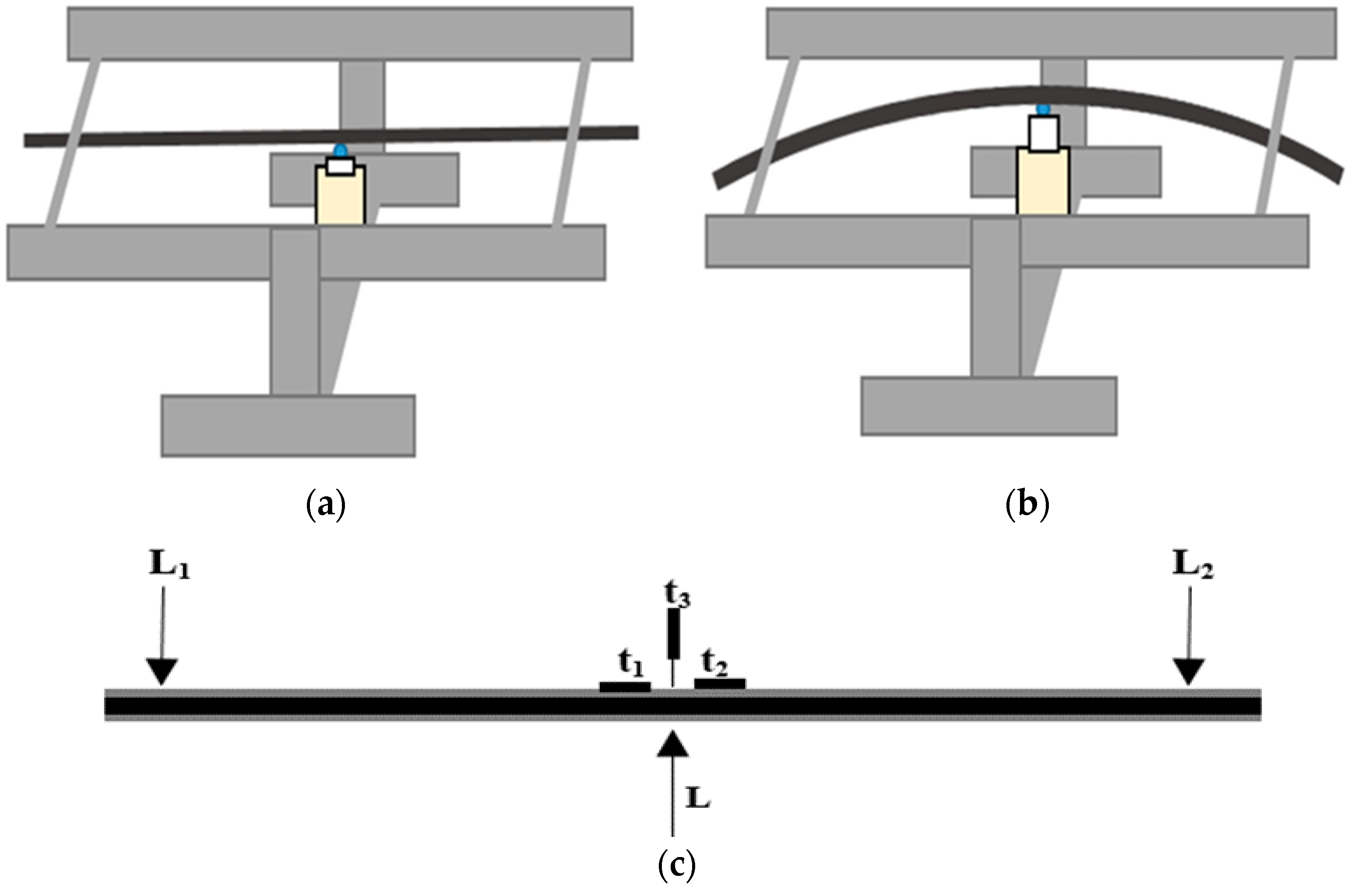


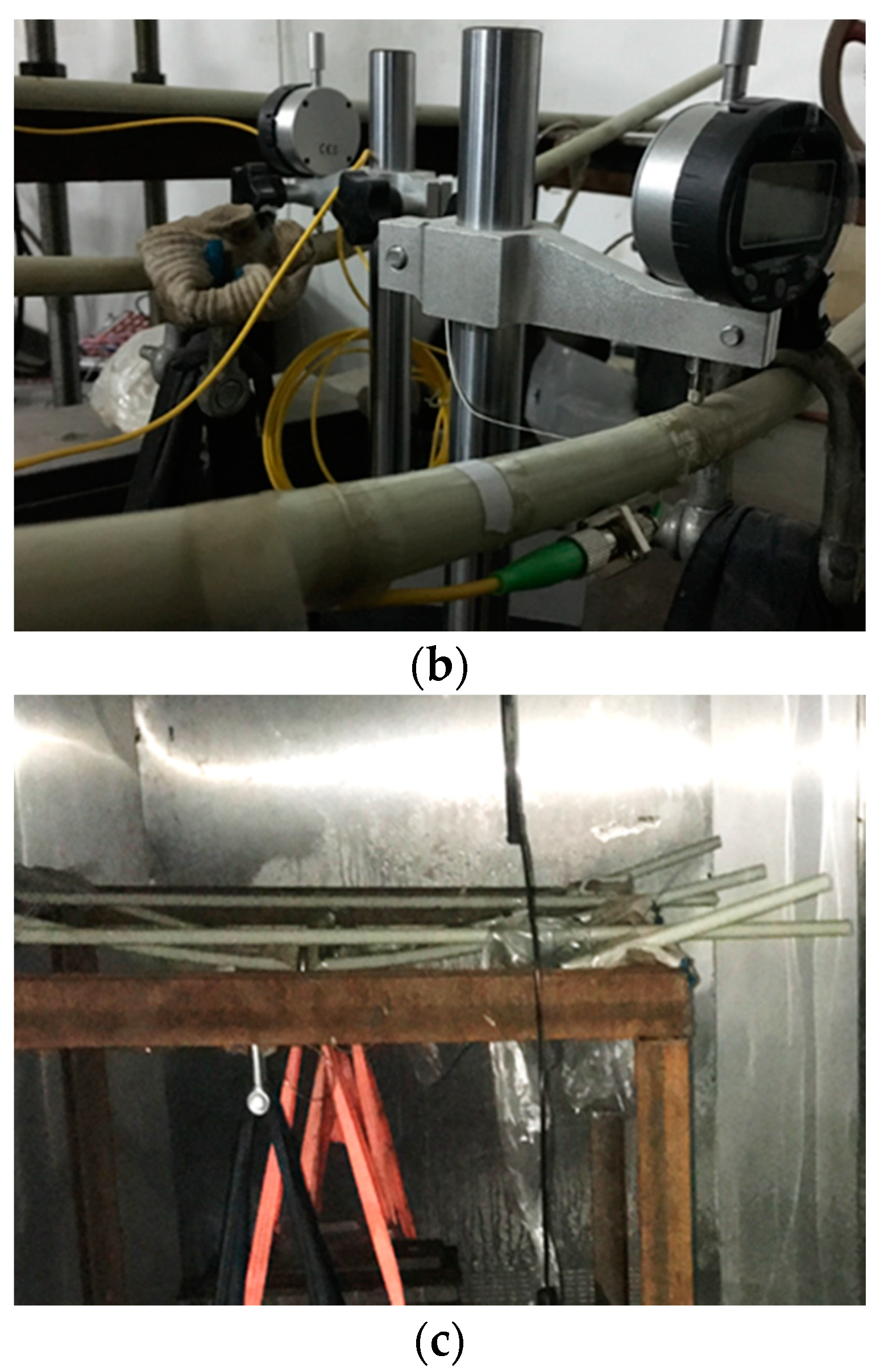
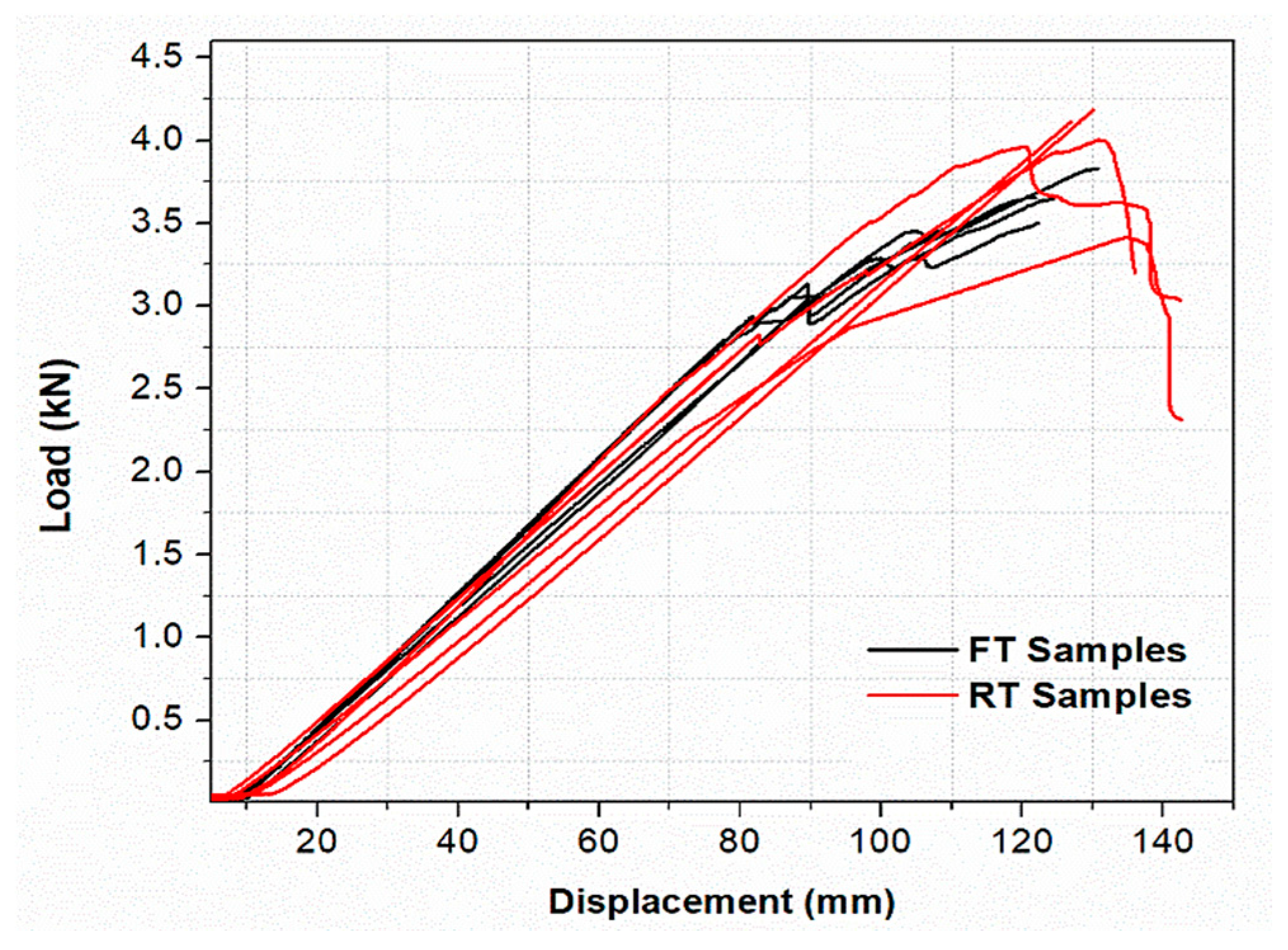

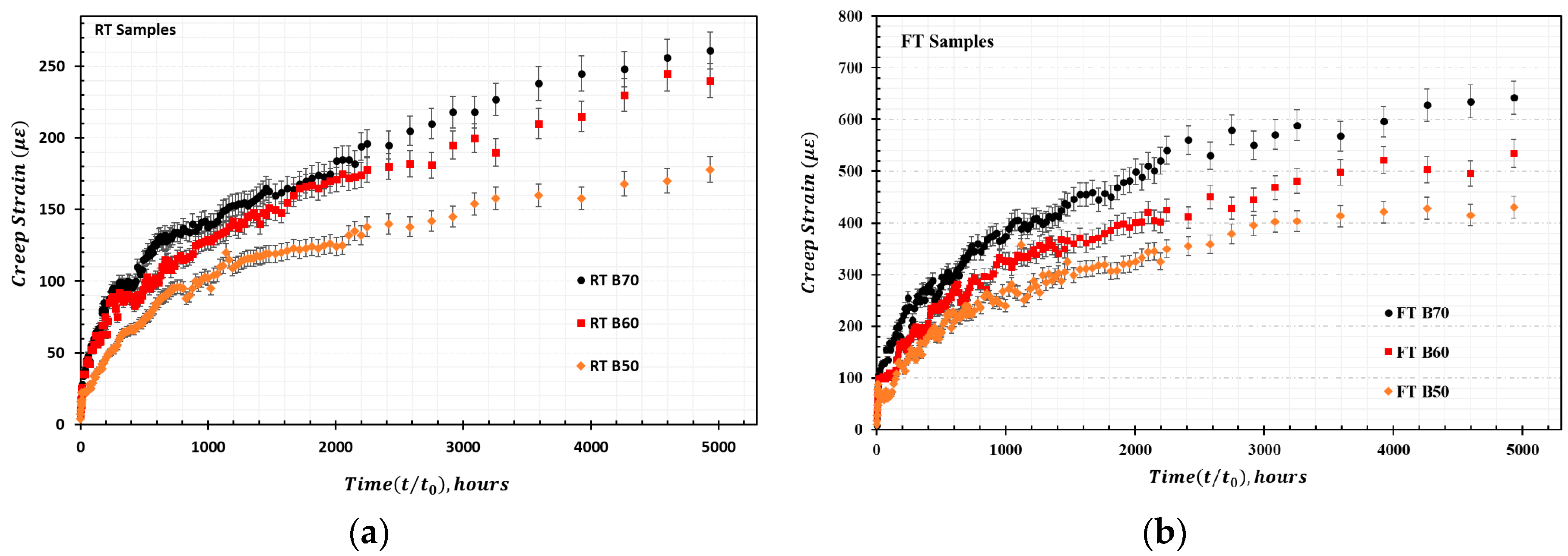
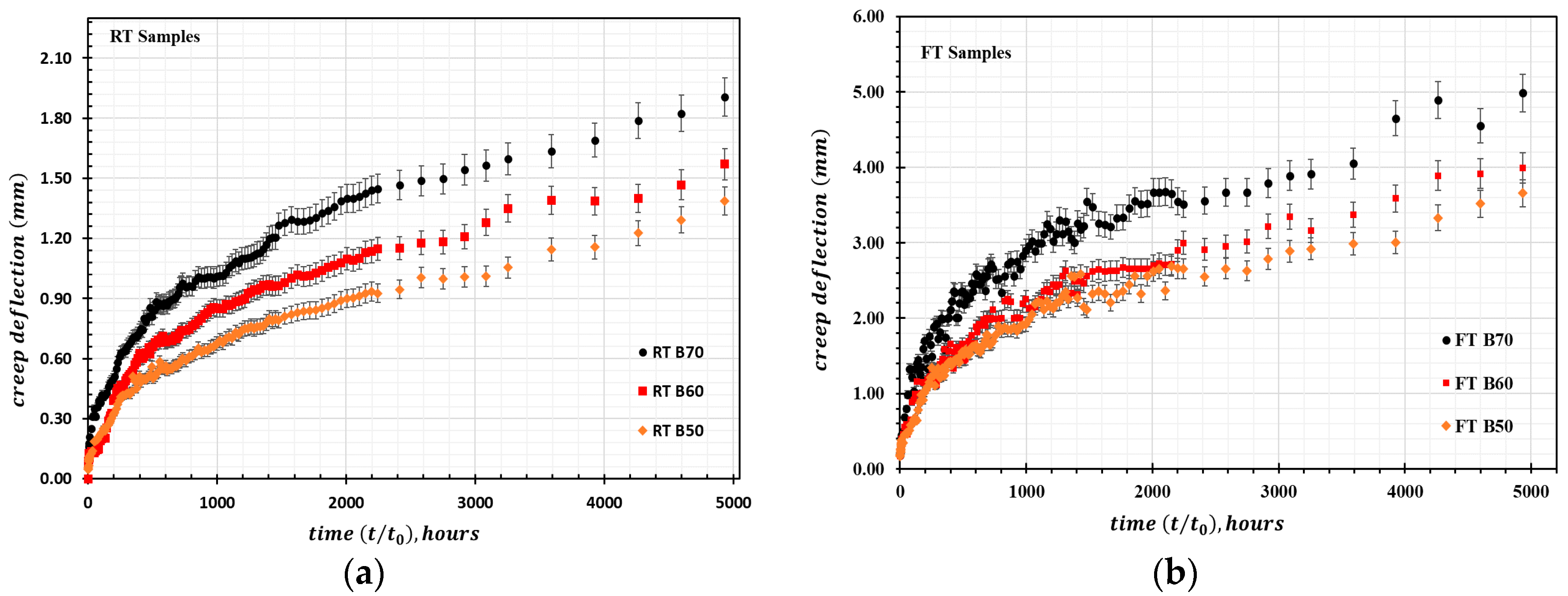
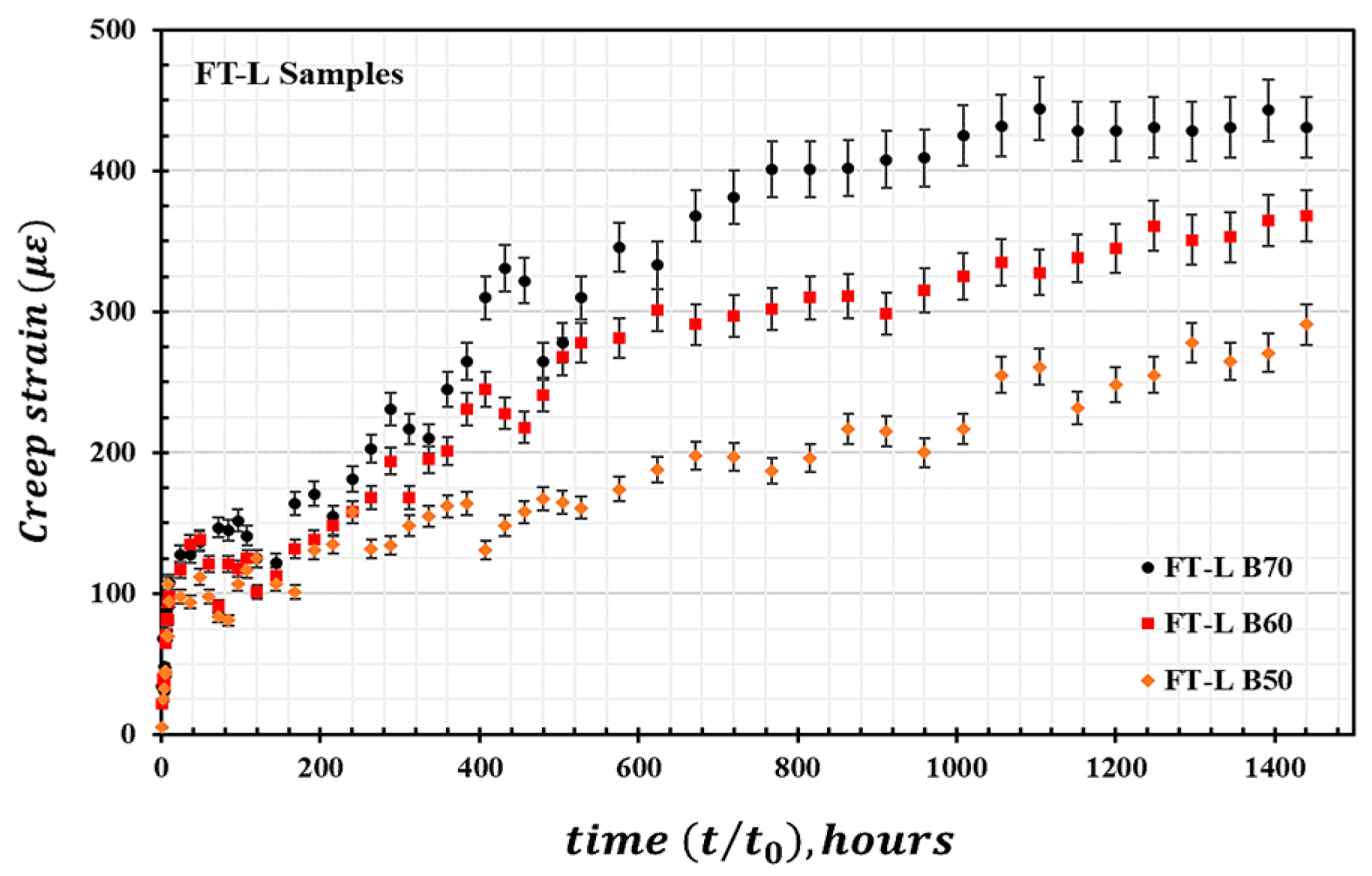



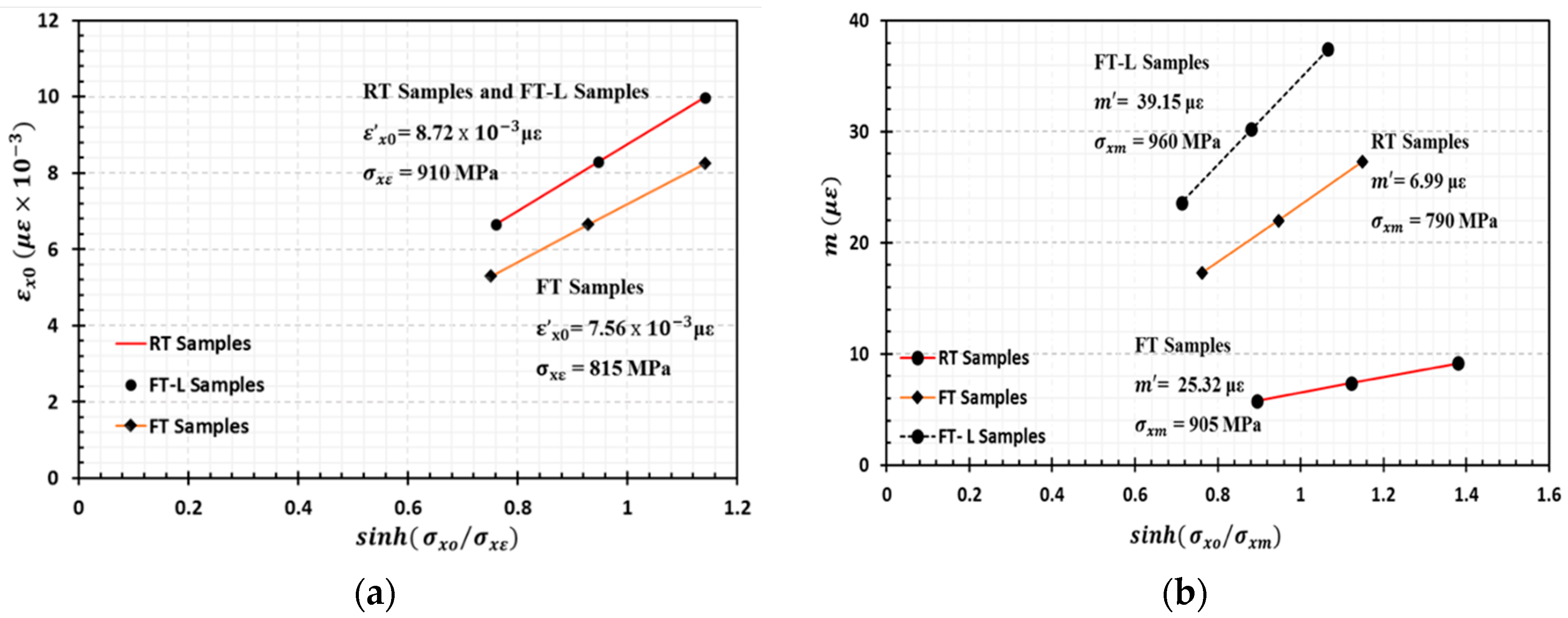
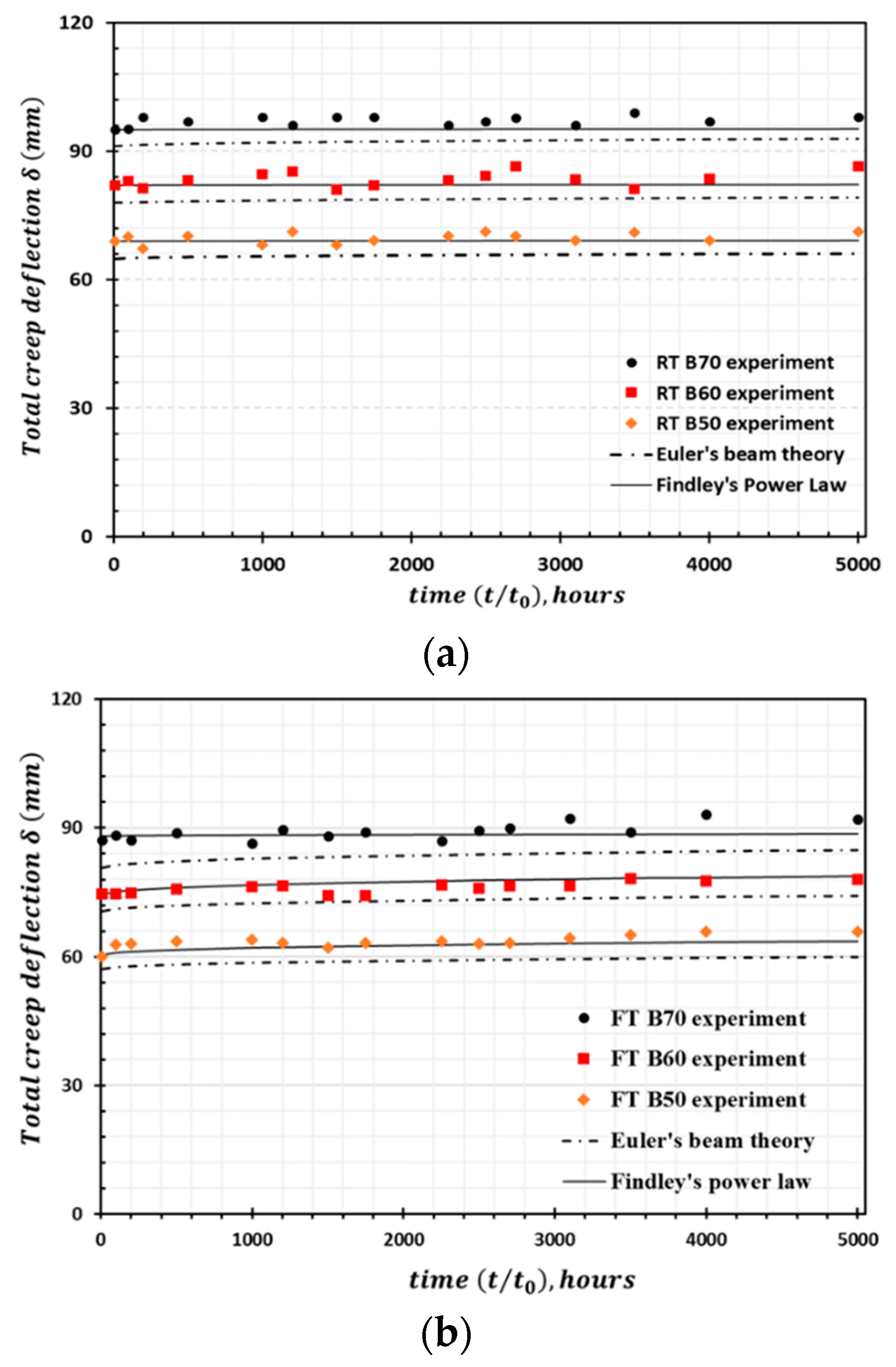

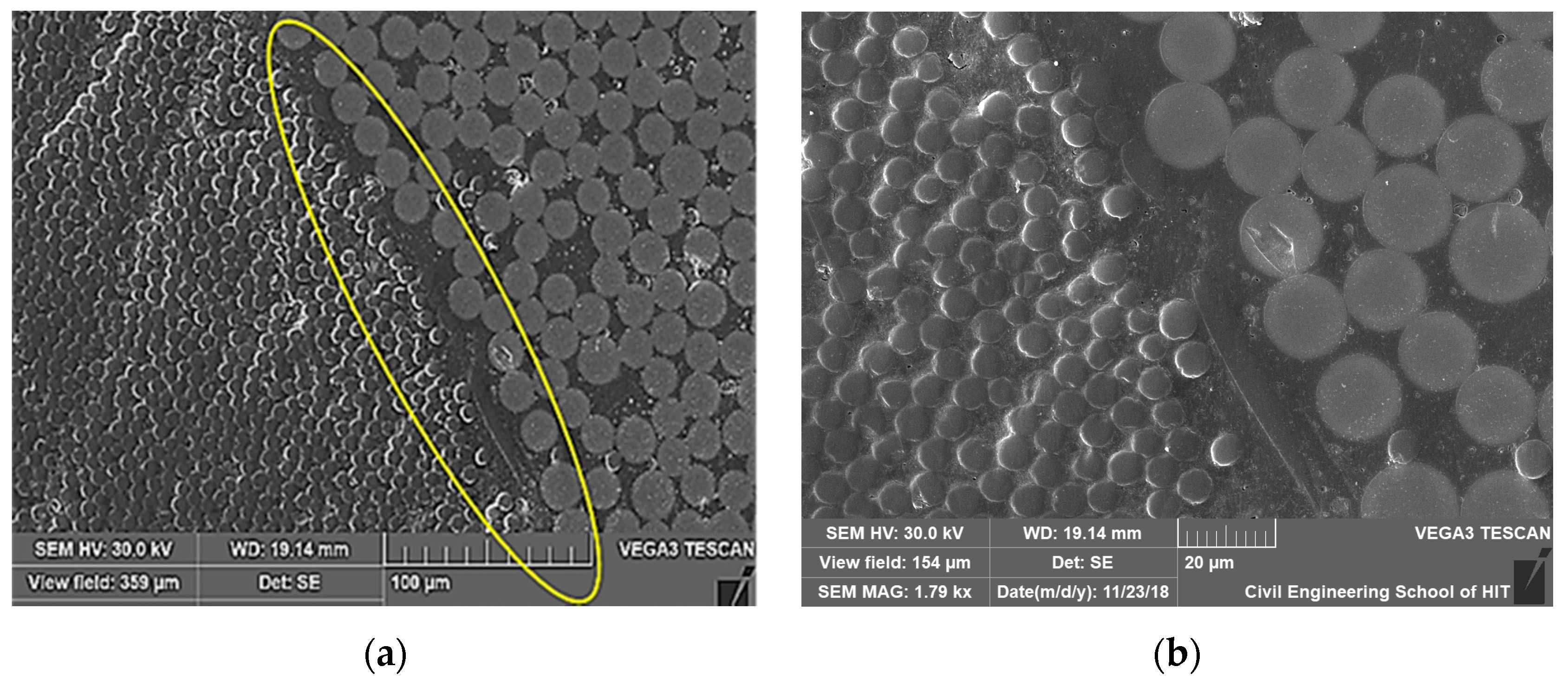
| Short-Term Properties | RT Samples, (CoV [%]) | FT Samples, (CoV [%]) |
|---|---|---|
| Flexural modulus (GPa) | 68, (14.96) | 68, (14.96) |
| Ultimate stress (MPa) | 1272, (10.84) | 1130, (8.31) |
| Ultimate strain (%) | 1.4, (11.29) | 1.2, (12.82) |
| Maximum deflection (mm) | 136, (6.68) | 125, (7.32) |
| Maximum load (KN) | 4.15, (8.13) | 3.68, (8.25) |
| RT Samples | ||
|---|---|---|
| RT B50 () | 638 | 6.66 |
| RT B60 () | 767 | 8.29 |
| RT B70 () | 890 | 9.98 |
| Average CoV (%) | 10.84 | 8.31 |
| FT Samples | ||
| FT B50 () | 566 | 5.50 |
| FT B60 () | 678 | 6.69 |
| FT B70 () | 795 | 8.25 |
| Average CoV (%) | 11.29 | 12.82 |
| FT-L Samples | ||
| FT-L B50 () | 638 | 6.66 |
| FT-L B60 () | 767 | 8.29 |
| FT-L B70 () | 890 | 9.98 |
| Average CoV (%) | 10.84 | 8.31 |
| Samples | |||
|---|---|---|---|
| RT B50 | 0.38 | 5.77 | 0.97 |
| RT B60 | 0.39 | 7.43 | 0.96 |
| RT B70 | 0.38 | 9.16 | 0.99 |
| FT B50 | 0.37 | 16.50 | 0.95 |
| FT B60 | 0.37 | 21.40 | 0.96 |
| FT B70 | 0.36 | 27.81 | 0.91 |
| FT-L B50 | 0.34 | 23.61 | 0.88 |
| FT-L B60 | 0.35 | 30.23 | 0.96 |
| FT-L B70 | 0.35 | 37.44 | 0.91 |
| Authors | Creep Loading | Duration (h) | Material (GFRP) | n |
|---|---|---|---|---|
| Bank and Mosallam [31] | flexural | 3500 | frame | 0.33–0.34 |
| McClure and Mohammadi [42] | compression | 2500 | coupons column | 0.25 0.17 |
| Scott and Zureick [43] | compression | 10000 | coupons | 0.23 |
| Choi and Yuan [44] | compression | 2500 | column 1 column 2 | 0.15 0.19 |
| Shao and Shanmugam [33] | flexural | 9000 | sheet piling | 0.30–0.36 |
| Mário F. Sá [32] | flexural | 1680 | coupons web coupons Flange beams | 0.21–0.22 0.33–0.36 0.31 |
| Mário F. Sá [35] | flexural | 3600 | panel | 0.19 |
| Time Years | (Ext) Reduction in Modulus (%) | χ (t) Reduction Factor | ϕ (t) Coefficient of Viscosity | ||||||
|---|---|---|---|---|---|---|---|---|---|
| RT Samples | FT-L Samples | FT Samples | RT Samples | FT-L Samples | FT Samples | RT Samples | FT-L Samples | FT Samples | |
| 5 | 4.31 | 10.47 | 8.98 | 0.94 | 0.90 | 0.91 | 0.065 | 0.1 | 0.98 |
| 10 | 5.52 | 12.97 | 11.31 | 0.92 | 0.87 | 0.88 | 0.086 | 0.14 | 0.13 |
| 25 | 7.38 | 17.02 | 15.18 | 0.89 | 0.82 | 0.84 | 0.1 | 0.20 | 0.17 |
| 40 | 9.61 | 19.48 | 17.64 | 0.87 | 0.80 | 0.81 | 0.13 | 0.24 | 0.21 |
| 50 | 10.75 | 21.00 | 19.00 | 0.86 | 0.79 | 0.80 | 0.15 | 0.26 | 0.23 |
| YEARS | RT B70 | FT B70 | RT B60 | FT B60 | RT B50 | FT B50 |
|---|---|---|---|---|---|---|
| [Percentage Increase in Creep Deflection (%), (Findley’s Power Law/Euler’s Beam Theory)] | ||||||
| 5 | 6.02/5.83 | 13.9/11.2 | 4.8/4.2 | 10.8/10.4 | 4.84/3.41 | 10.9/10.04 |
| 10 | 8.2/6.4 | 17.5/14.4 | 6.3/5.8 | 14.01/13.2 | 6.3/4.81 | 13.4/12.1 |
| 25 | 11.08/9.03 | 25.8/21.2 | 9.1/7.8 | 20.1/18.5 | 8.94/7.01 | 19.1/17.4 |
| 40 | 13.21/9.45 | 28.9/25.1 | 10.7/9.2 | 24.7/22.1 | 10.5/8.69 | 23.6/20.9 |
| 50 | 15/11.1 | 30.7/26.6 | 11.7/10.2 | 25.6/23.9 | 11.14/9.4 | 24.4/21.6 |
© 2020 by the authors. Licensee MDPI, Basel, Switzerland. This article is an open access article distributed under the terms and conditions of the Creative Commons Attribution (CC BY) license (http://creativecommons.org/licenses/by/4.0/).
Share and Cite
Mayookh Lal, H.; Xian, G.; Thomas, S.; Zhang, L.; Zhang, Z.; Wang, H. Experimental Study on the Flexural Creep Behaviors of Pultruded Unidirectional Carbon/Glass Fiber-Reinforced Hybrid Bars. Materials 2020, 13, 976. https://doi.org/10.3390/ma13040976
Mayookh Lal H, Xian G, Thomas S, Zhang L, Zhang Z, Wang H. Experimental Study on the Flexural Creep Behaviors of Pultruded Unidirectional Carbon/Glass Fiber-Reinforced Hybrid Bars. Materials. 2020; 13(4):976. https://doi.org/10.3390/ma13040976
Chicago/Turabian StyleMayookh Lal, Hiran, Guijun Xian, Sabu Thomas, Lei Zhang, Zhonghui Zhang, and Huili Wang. 2020. "Experimental Study on the Flexural Creep Behaviors of Pultruded Unidirectional Carbon/Glass Fiber-Reinforced Hybrid Bars" Materials 13, no. 4: 976. https://doi.org/10.3390/ma13040976
APA StyleMayookh Lal, H., Xian, G., Thomas, S., Zhang, L., Zhang, Z., & Wang, H. (2020). Experimental Study on the Flexural Creep Behaviors of Pultruded Unidirectional Carbon/Glass Fiber-Reinforced Hybrid Bars. Materials, 13(4), 976. https://doi.org/10.3390/ma13040976






